Artist Dawn Gerety, 48, was raised in Girdwood, Alaska and has always found inspiration in the peaks of the Chugach Mountains. Her biking, skiing and paddling pursuits instilled in her a desire to capture her passion for her natural and social communities.
A start in graphic design allowed Gerety to make it as an artist from an early age, but she realized that time behind a screen was not an ideal way to spend her days. So she taught herself to paint and has spent the last seven years translating her love of the outdoors onto the canvas. We caught up with Gerety to learn more about her process.
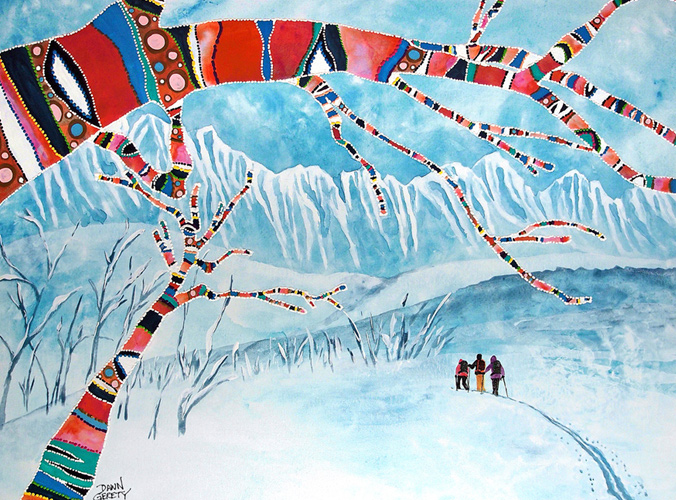
Image Title: The Approach
Backcountry Magazine: Have you always loved living in Alaska?
Dawn Gerety: Where I grew up in Girdwood, Alaska is right in the heart of the Chugach Mountains, at the base of the Alyeska Resort. I went to school in Anchorage, and my parents had built a cabin underneath the ski resort, so that’s where I grew up with my two younger sisters. Skiing pretty much defined our lives throughout our youth and into college, where my sisters continued with racing. We’ve all been a part of the skiing community in some way since. I chose to stay in Alaska after college, because once I returned with a degree in Environmental Design and Fine Art History from the University of Colorado, Boulder, Alaska opened up to me in a very different and new way than when I was living at home with my parents.
All of a sudden I was river running and white water kayaking with my friends—we were taking multi-day trips and were exploring in a different way than what I knew growing up. And, also, my experience in the lower 48 with the amount of people and the bigger cities and navigating all of that was a little foreign to me, so being at home was more comfortable. I love leaving and visiting other places, but I always love coming back home.
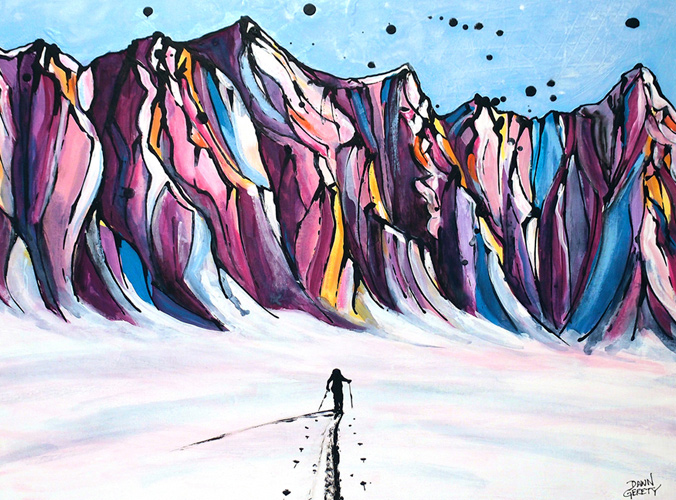
Image Title: Solo Stoke
BCM: Art has been a longtime interest of yours, but it sounds like it’s morphed. What got you started in art, and how has it evolved?
DG: For as long as I can remember—going all they way back to elementary school—crafts, creating and making things has just been a part of my life; it’s what makes me tick. I took as many art classes as I could in high school. When I went to college, I was stressed about an environment where I was expected to be super academic and pressured to decide on my career direction. When I found out that I could take art classes, I more easily embraced going away to school. I learned as much as I could at university about art and design, but there wasn’t any art education available on a computer yet. So, after college, I taught myself Photoshop and Illustrator and went into graphic design. And I’ve been freelancing graphic design out of my home ever since. For a long time, that was my creative fix, along with some projects on the side. But I realized about seven years ago that I was becoming a hostage to my keyboard, and I needed another outlet for my creativity. So I taught myself how to paint. A lot of companies want everything that they stand for to be captured in a two-inch by two-inch logo, but I needed to break free of those restrictions with my painting.
Graphic design was the artistic springboard for me in my community, because in the Alaska setting, everyone who is starting businesses needs logos and brochures, so I was involved with like-minded people in my community, and I was also a partner with them in doing the design work. Eventually that artistic expression moved to the canvas.
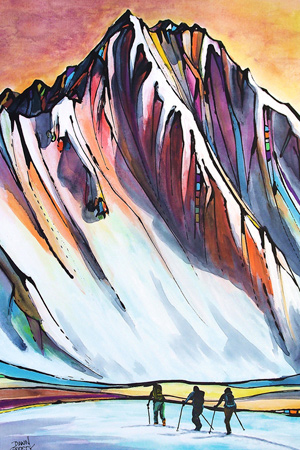
Image Title: Spring Tour
BCM: How has your environment been an inspiration?
DG: In teaching myself to paint, I wanted to make it as easy on myself as possible without being stressed about it, so I thought I would paint what was around me. And in Alaska, that’s a lot of wildlife and flowers. And that helped me evolve a painting style, which was very immature at that point.
I left to do a trip to Australia for a year, and that’s really where I developed my painting. I painted everything around me—their animals, their people and landscapes—and that inspiration and a chance to paint really helped strengthen my style when I returned to Alaska. I could then translate some of the things I got better at while in Australia into what I was seeing in my home community.
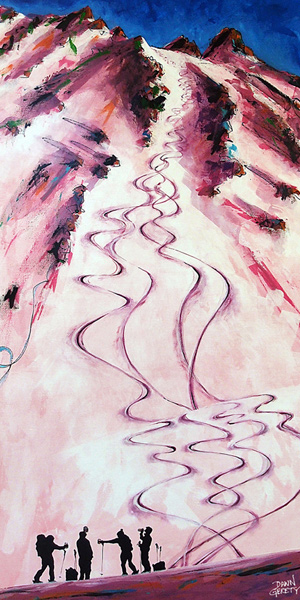
Image Title: Apres Alpenglow
BCM: How do your recreational pursuits affect your art?
DG: I like gravity sports—downhill biking, river running hiking, cross-country biking, skiing. I now own a snow machine, so if I’m not hiking, I’m accessing the mountains somehow, maybe just with a motor. And there’s not a lot of art about that stuff, so it’s really enjoyable to create it and have it received by other people around me who are doing the same thing.
BCM: What’s the artistic process look like for you?
I consider myself better when I work on larger canvasses, like three to four feet or something even larger. So my originals are large—I can’t put them in a backpack or go out into the mountains and start drawing things. I tend to do a lot of things off of photos. I like having specific mountains in my paintings, but I tend to tweak them out and give them a different character. And I started using a lot of photos that heli operations take, because they have a lot of different perspectives and views as well as some surprisingly large libraries of photos they take for their clients. They were happy to have me look through things, but now I try to take my own photos while I’m driving my car or looking at the mountains around me. I’m always trying to see if there’s a different angle at the ski resort or wherever I am. But I do all of my work in my studio, and I paint with my canvases flat so that I can make my work really watery and wet. And then I let it dry and I keep adding layers on top of that.
BCM: Explain your reasoning behind the way you juxtapose trees with snowy backdrops.
DG: I think of my style as being in chapters, and for that particular chapter I was really trying to play with loose, wetter backgrounds and a very controlled stylized elements layered on top of that. For me it was an easier way to create layers. I do a lot with flowers that way, but most people who live in the area around Girdwood recognize my trees. I just wanted to have the trees, mountains and animals be very whimsical and not perfect—fun and feel good.
BCM: How do you view your art as a part of your overall identity and wellbeing?
DG: I read somewhere once that the health of a civilization can be measured by the art that was produced. And the way I see it is that if there was no art coming out of a civilization, then they were just trying to survive. And if I translate that to myself, the amount of art and the art I’m producing is a reflection of my physical and mental health and what I’m doing in my life. And I try to play and make as much art as I can.
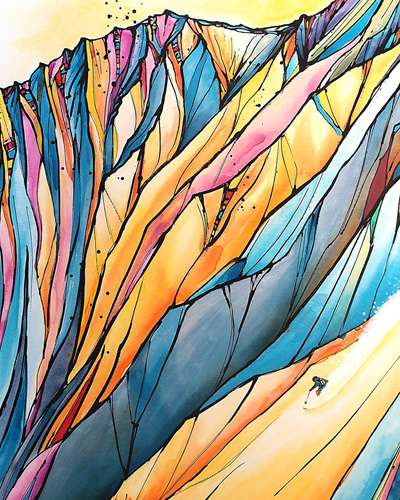
Image Title: Nirvana
BCM: How does your sense of place affect your art?
DG: We are nestled in the Chugach and these peaks are very recognizable, so I love incorporating them into my painting. Where I live in Girdwood is the northernmost rainforest in North America, and the amount of precipitation we can get in our area is epic. When it snows, it’s so inspirational to see the snow stack up on the trees. That’s what I love to represent.
But place, community and art all feel like one to me. Art keeps me in the game in terms of being recognized for being in the community and enjoying all the things that that delivers. I am more social and connected because of it. And conversely, the community and surroundings are my inspiration for art.
—
To see more of Gerety’s art, visit artseriously.com.










Beautiful